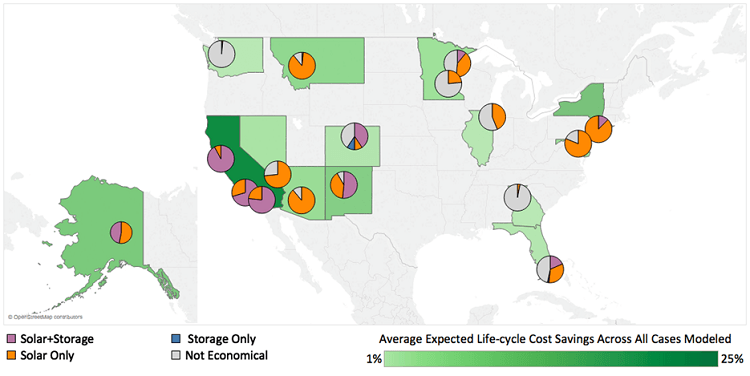REopt Evaluates Commercial Solar Plus Storage

A map summarizes the average potential for savings from solar or solar plus storage in commercial buildings. The darker shaded states were found to have higher potential for savings, and the pie charts indicate the degree to which each technology combination contributed to the cost reduction. Illustration from NREL
NREL used the REopt® model to evaluate the economics of solar paired with battery storage across the country, conducting thousands of optimization runs to evaluate economic viability across different building types, climate zones, and utility rate tariffs. NREL’s analysis considered multiple potential value streams including peak shaving, energy arbitrage, frequency regulation, capacity markets, and the value of resilience. The results show where solar and storage may be cost-effective in the near-term and long-term.
The REopt analysis is being used to identify cost-optimal technology combinations of solar and storage for a variety of building types and market conditions; explore methods to value the contribution of solar-plus-storage to electric system resilience; characterize market potential for multiple technology and policy trajectories; and support identification of policy and regulatory options to support solar-plus-storage deployment.
Related Stories
Renewable Energy journal article: Impacts of Valuing Resilience on Cost-Optimal PV and Storage Systems for Commercial Buildings
NREL presentation: Identifying Critical Factors in the Cost-Effectiveness of Solar and Battery Storage in Commercial Buildings
NREL brochure: Identifying Potential Markets for Behind-the-Meter Battery Energy Storage: A Survey of U.S. Demand Charges
NREL brochure: Valuing the Resilience Provided by Solar and Battery Energy Storage Systems
NREL presentation: When Solar + Storage Makes Sense
NREL conference paper: A Statistical Analysis of the Economic Drivers of Battery Energy Storage in Commercial Buildings
NREL poster: Optimizing Energy Storage Economics
NREL technical report: Optimal Sizing of a Solar-Plus-Storage System For Utility Bill Savings and Resiliency Benefits
OpenEI website: Solar+Storage
Sponsors
Department of Energy Solar Energy Technologies Office
Key Partners
Clean Energy Group
Contact
Share